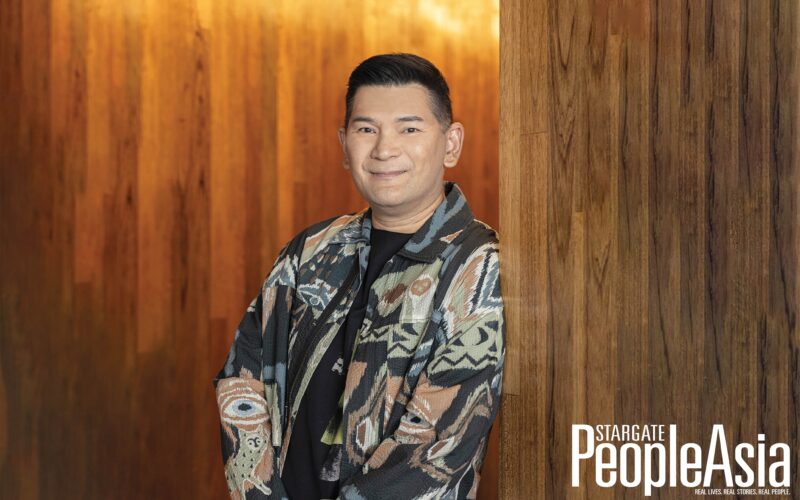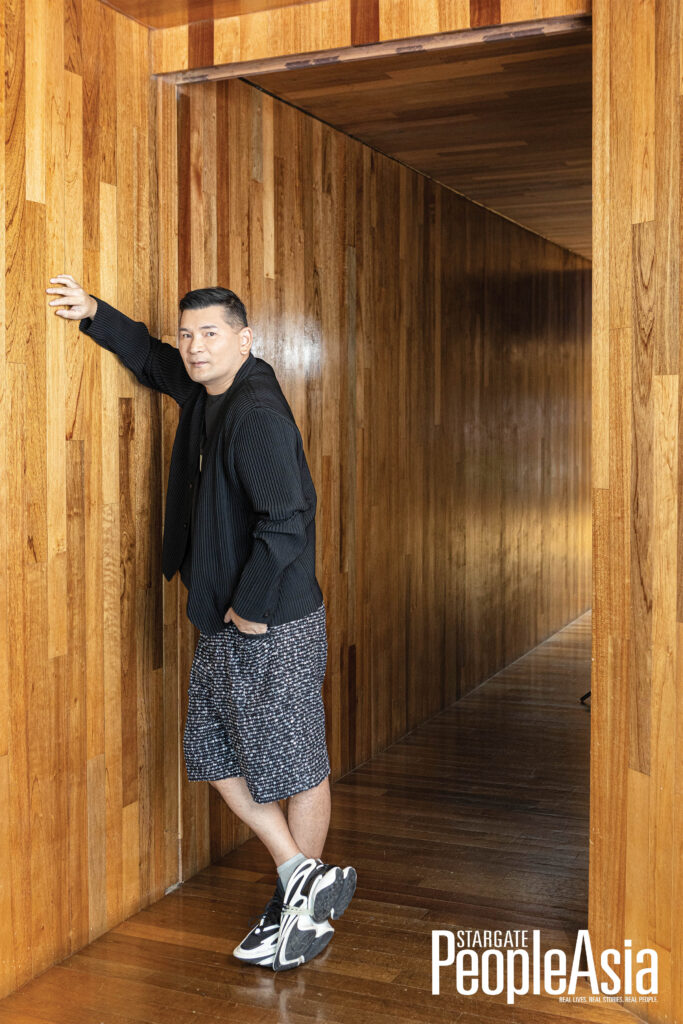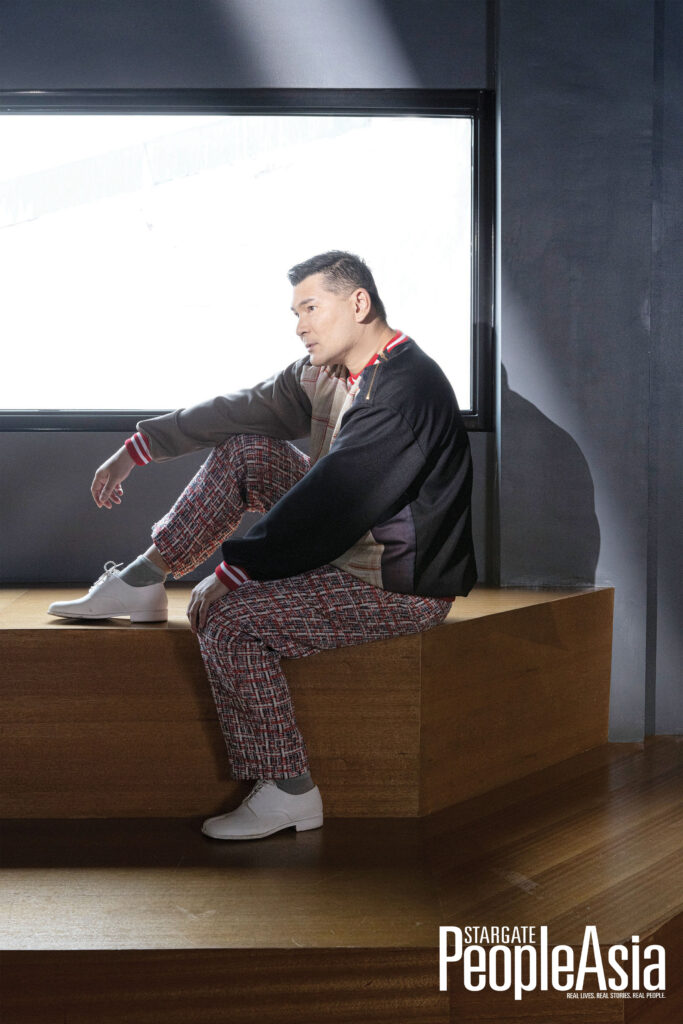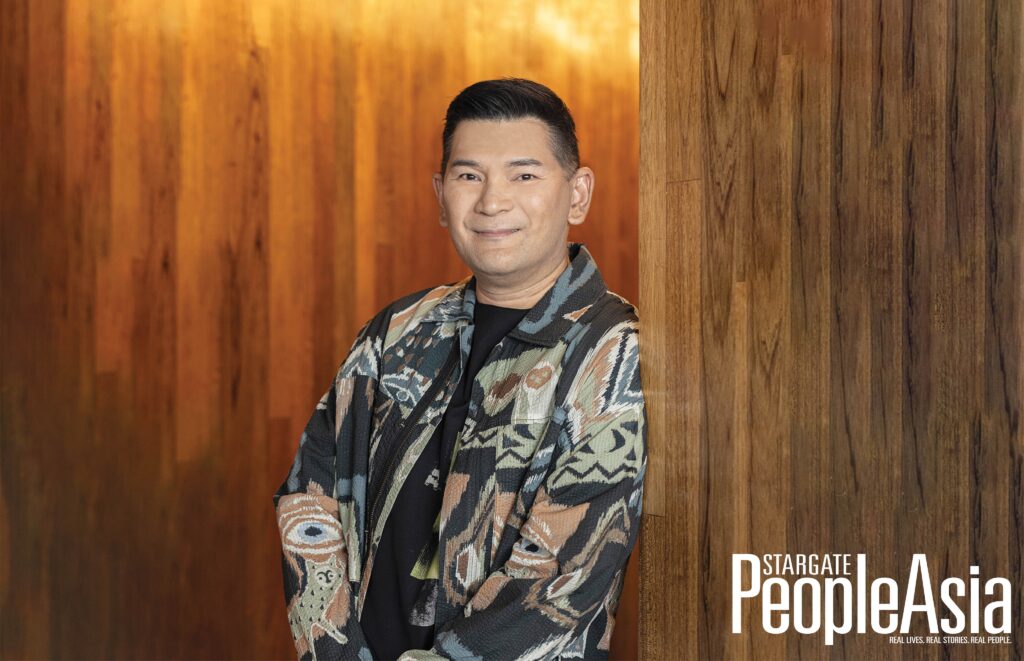By ALEX Y. VERGARA
PHOTOGRAPHY by JAR CONCENGCO
ART DIRECTION by DEXTER FRANCIS DE VERA
Nearly 30 years after he established SAGA, one of the country’s leading events and production outfits, Robby decided to step down in 2021 as its CEO to focus exclusively on the company’s lifeblood — directing fashion shows, live corporate events and product launches. He also wants to do more “purposeful” events from hereon.
The word pivot may have gained renewed currency as everyone tried to adapt and survive in the immediate aftermath of the COVID-19 pandemic, but to fashion show director Robby Carmona, who has lived more than half of his life in front of and behind the spotlight, making sure that everything goes according to plan while also bracing himself for the unexpected, shifting gears and even making sudden 180-degree turns is no longer new.
Thus, Robby, arguably the country’s most in-demand captain of the ship these days when it comes not only to fashion shows, but also to live corporate events and grand product launches, found himself pivoting anew by voluntarily stepping down in late 2021 as CEO of SAGA, the events and production company he founded and led as an energetic and intrepid twenty-something way back in the early ’90s.
It wasn’t an easy decision to make. “My gosh, para akong nakipag-break sa longtime jowa ko. Iyak ako nang iyak,” he says. (It was like I broke up with my longtime partner. I was crying my heart out). But it was a decision he had to make to save and ensure the longevity of his beloved company and perhaps keep his sanity intact.
Painful as it was, the move also brought him much-needed relief, as it has now freed him from the daily grind of running a company that he and a cousin started nearly 30 years ago in the living room of his rented apartment along Boni Avenue in Mandaluyong City. With a telephone, several chairs and tables, and a trusty typewriter, Robby opened shop amidst what was then considered the city’s creative hub where fellow creatives were clustered. He did so without the slightest inkling he’d one day become one of the biggest and most influential names in the local fashion scene.
Back with a vengeance
Pre-pandemic, Robby was mother hen to 49 regular employees, whose number quickly went down to 24 as the staging of live shows and events ground to a halt in March 2020. Now that events are back with a vengeance, SAGA’s workforce has nearly doubled to 73 and counting.
“Because there’s this ongoing revenge on almost every aspect of our lives, we at SAGA have also experienced a rebound,” he says.
Going back to those dark days in late 2021, Robby, with mixed emotions, passed on his manager’s hat to Elmer Lapeña and Julie Ann Aguila, two longtime employees and former protégées. That both are also live events directors steeped in the ways of running a creative company themselves is one less worry for their former mentor.
But before Robby passed on the baton to them, he “empowered” his two GMs with shares while also helping the company create a management committee. As company founder, Robby remains a major stockholder at SAGA. His decision though to relinquish one of his crowns, so to speak, also meant giving up his role as a managing partner.
“Imagine, before that, my days were divided doing admin and management work, including operations and human resources, as well as creative work. It took a pandemic to make me realize that I have done everything possible as a manager to steer the company and make it flourish,” he shares.
Amidst the uncertainty, Robby was quite certain about one thing. He had to bring in new blood if he wanted to see his baby grow further and reach new heights. At the same time, freed from office work, Robby now has more time to research and focus on the company’s lifeblood.
After all, it is through these shows that Robby, a born visual storyteller, expresses himself. “My work as a creative person gives meaning to my life. In many ways, it is my life,” he declares.
No theater background
The fact that he has no background in theater arts makes his journey to reach the top of his chosen profession even more amazing. Ever since he can remember, Robby, a product of Colegio San Agustin, has loved to dance on stage. He also has an ear for music, which, unbeknownst to him, would come in handy years later as a director.
“Singing? That’s one talent that the Lord didn’t give me,” he says with a hearty chuckle. “Otherwise, baka nag-artista na ako. (I probably would have joined the movies.)
As the son of Derek Carmona, one of the country’s top male models back in the ’70s, Robby is also blessed with good looks and the height to match, which he initially parlayed into a modeling career both on the ramp and in TV commercials starting in his late teens.
He divided his time between modeling and studies, taking up Marketing Management at the De La Salle University. But his budding career and education soon had to take a backseat when Robby, then barely 20, made a life-changing decision to fly to Japan to work as an entertainer.
“I was educated in good schools, but my family later experienced financial difficulties that prompted me to support myself in college. Then the opportunity to work in Japan came along,” he recalls.
His six-month stint in Japan eventually led him to drop out of college altogether. In return though, he gained something that during those pre-Internet days was priceless — a mind full of new and out-of-the-box ideas that unwittingly became the seeds of a lifelong career.
“I had to return to Manila after six months to take a break because that was the rule in Japan back then in order for you to renew your work visa,” Robby explains. “Otherwise, I would have worked there nonstop because I love everything about Japan. It was like I was living in a different planet!”
But Robby had to find other sources of income upon his return. Going back to modeling no longer appealed to him partly because the scene had abruptly changed during his brief absence. “It was getting crowded, as new faces were popping up out of nowhere. Unlike in the case of female models, who become more seasoned with each passing year, the turnover for male models is much faster,” he explains.
From modeling to casting
Since it takes one to know one, Robby soon found himself spreading his wings instead as a talent caster for some of the country’s top ad agencies. One of his biggest projects, he recalls, was the launch of Head & Shoulders shampoo in the Philippines where he was able to convince the late Fanny Serrano, then an A-list makeup artist and occasional performer, to star in the breakout TV ad.
Despite his packed schedule, Robby, like most young people his age, still had loads of energy to party at night. He was a regular at the now-defunct Mars Disco where he met Carmina Sanchez, then the nightspot’s marketing manager and now one of Manila’s leading fashion impresarios, who later convinced him to direct the fashion show of a certain newbie designer named Rajo Laurel.
“For some reason, I said yes,” says Robby with a laugh. “Never mind if my only directing experience back then was doing mini shows and campus beauty pageants at school, I ended up sitting down with Carmina and Rajo to plan the show. It was a happy time, as I remember the three of us sitting on the floor and cutting into strips the shower curtains we bought at SM, which would become part of the show’s backdrop.”
With insights and images he imbibed from Japan still percolating in his head, Robby slowly conquered the stage, one show at a time, earning for himself such monikers as “Disco King,” “because most of the early fashion shows I did were held in dance clubs,” he says, and “Enfant Terrible of Philippine fashion.”
Robby recalls one instance when a “follow spotter,” literally the person in charge of following the movements and training the spotlight on a featured performer on stage, asked the then newbie Robby, “Direk, saan po natin ipo-focus ’yung ilaw? (Direk, where should we focus the spotlight?)”
“Direk”
“It was the first time somebody called me ‘direk,’” he says. “I couldn’t seem to believe what I heard that there was a lull in my reaction. But after what seemed like a long time, it finally sunk in. Direk. Hmmm, I kind of liked the ring to it. After all, I was now wearing the headset.”
From the confines of Mars, Robby soon graduated to doing fashion shows in malls and hotels, which were mostly in conjunction with product launches. He credits the likes of veteran marketing man Edd Fuentes, whom he knew since his days as a model and caster, for believing in him and giving him the chance to direct such shows.
“Suddenly, my days as an entertainer in Japan seemed like a distant memory,” says Robby. “Even if I wanted to, as I immensely enjoyed working with fellow Filipinos there, going back to Japan was no longer an option. Modesty aside, I suddenly found myself swamped with offers to direct fashion shows.”
Before demand for his services went through the roof, Robby had already put up SAGA. He recalls one of his biggest breaks back then as director happened when an intermediary of Inno Sotto called him up to tell him that the veteran designer was planning a show and he wanted Robby to direct it. He was also told to expect a call from Richard Tann, then Inno’s partner and business manager.
“I tried to sound as unaffected as possible,” says Robby. “Deep down, I was excited, of course, but like almost everything in life, nothing happens until it happens. And once I got the call from Richard, I suddenly found myself shaking as soon as I put down the receiver. Inno Sotto na ito! ’Yun ’yung time na naramdaman ko na isa na akong ganap na direktor.” (We’re talking Inno Sotto here! That was the time when I realized that I’m now a full-fledged director.)
His quest to improve himself as a person and as a director continues. These days though, Robby wants to focus more on “purposeful events” that touch people’s lives. One such show he directed was the recent I Want to Share Foundation’s gala event, which featured young cancer warriors as models.
“Not that what I’ve done before didn’t matter. I’d like to believe my work has helped a lot of models, designers and people behind those brands. Through fashion, those shows also inspired countless people to aspire to look and be their best,” he says, turning teary-eyed as he recalls the joy and fulfillment he felt while working with children afflicted with cancer.
Indeed, there’s more to fashion than the fabulous clothes and the demigod-like models who wear them.
And Robby, who’s on his third decade in the events business, has made it one of his life’s missions to continue reminding people of that.








